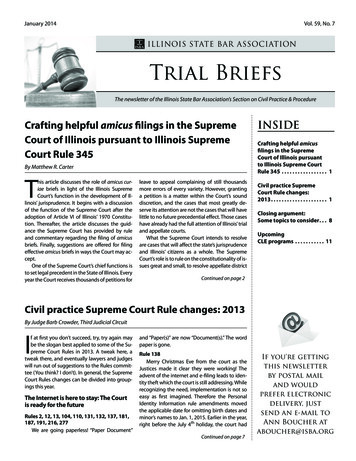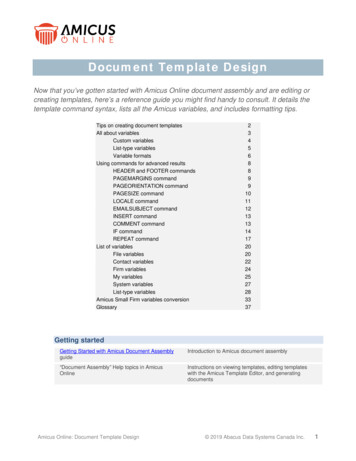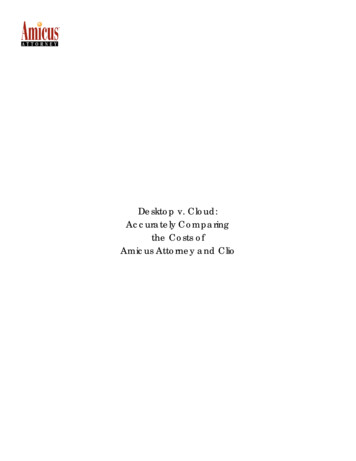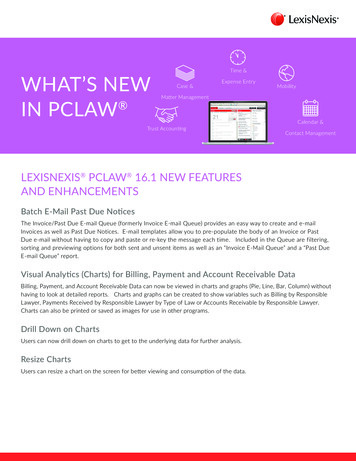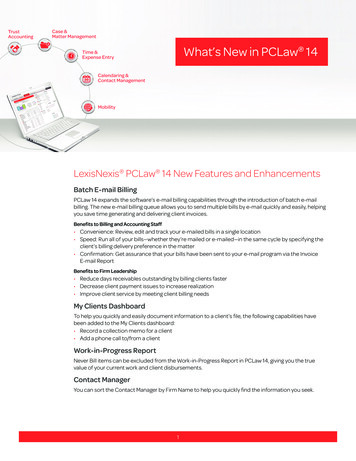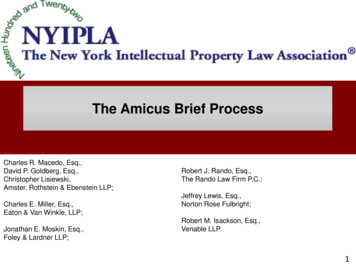
Transcription
The Amicus Brief ProcessCharles R. Macedo, Esq.,David P. Goldberg, Esq.,Christopher Lisiewski,Amster, Rothstein & Ebenstein LLP;Charles E. Miller, Esq.,Eaton & Van Winkle, LLP;Jonathan E. Moskin, Esq.,Foley & Lardner LLP;Robert J. Rando, Esq.,The Rando Law Firm P.C.;Jeffrey Lewis, Esq.,Norton Rose Fulbright;Robert M. Isackson, Esq.,Venable LLP.1
DISCLAIMER The following presentation reflects the personal opinions of itsauthors and does not necessarily represent the views of theirrespective clients, employers or of the New York IntellectualProperty Law Association. Additionally, the following contentis presented solely for the purposes of discussion andillustration, and does not comprise, nor is it to be considered,as legal advice.2
Agenda Introduction: Background on the Amicus Briefs ProcessConflict Clearance: NYIPLA and Other GuidelinesPro Bono Credit: Discussion of Pro Bono Credit RequirementsFederal Circuit Amicus Briefs: Formal Considerations, includingselected examples from NYIPLA Federal Circuit Amicus BriefsSupreme Circuit Amicus Briefs: Formal Considerations, includingselected examples from NYIPLA Supreme Court Amicus BriefsConclusion: Some Strategic ConsiderationsSuggested Additional ReadingQuestions?3
Introduction: The Amicus Briefs Committee The Amicus Briefs Committee (“ABC” or “Committee”) representsthe New York Intellectual Property Law Association’s (“NYIPLA” or“Association”) diverse Intellectual Property constituency before thecourts. In particular, the ABC coordinates the activities of theAssociation in the preparation and filing of briefs amicus curiae andmakes recommendations with respect thereto to the Board ofDirectors.4
Introduction: Committee Guidelines NYIPLA guidelines mandate that the “substantive touchstone for theCommittee . . . Should be an overriding concern for improvements inthe application of the intellectual property laws by the courts andagencies in a consistent fashion which fulfills their Constitutionallymandated objectives. Additionally, the Association’s substantivepositions should be formulated with a view to transparency, clarityand predictability.” Association guidelines also state that to the extent possible, theABC should “avoid positions and arguments which might offend thelegitimate concerns of significant minority membership factions.” Finally, guidelines admonish that “the Committee should strive for atone that is neither overtly partisan nor strident.” As a practical matter, please note that 9 of the 16 NYIPLA BoardMembers must approve of a proposed Amicus Brief for it to be filedon the Association’s behalf.5
Introduction: Committee Practice In accordance with these guidelines, the ABC leadership: Strives to ensure that all sides of the issues presented by thecases before the Committee are fairly and thoroughly representedin Committee meetings; Seeks to bring the Committee to a consensus position based onthe legal merits of the cases before the Committee; and Helps volunteer brief writers to prepare proposals to the Board,draft Amicus Briefs for Board approval, and file Amicus Briefs withthe appropriate Court. The Committee primarily prepares and files amicus briefs in the USCourt of Appeals for the Federal Circuit and in the US SupremeCourt. That said, the Committee occasionally prepares briefs thatare filed in other federal appeals courts, in state supreme courts, orin other venues.6
Introduction: Committee Members Amicus briefs are prepared by ABC members on a volunteer basis. The Committee recognizes that its members have different skillsets and time constraints. Accordingly, the Committee encouragesALL WHO ARE INTERESTED (and who have no conflicts) TOPARTICIPATE in the brief writing process. Members can participate in a number of different ways, dependingon their strengths and availability. Some Committee members maywish to take the lead in drafting arguments and giving voice to theAssociation’s concerns. Others may wish to participate in theediting process to refine the brief and its tone. Still others may wishto provide legal research in their areas of expertise, or otherwisecontribute to the amicus brief preparation process, such as assistingwith logistics or cite checking.7
Conflict Clearance: NYIPLA Guidelines The NYIPLA has mandated that the Committee “should strive toprevent undue influence by the parties in interest over the amicusprocess, and will require disclosure of all current representation ofthe parties in interest by the Committee . . . Members.” The Association also understands that ABC members “almostalways will have a philosophical position they wish to espouse” and“may have clients that, although not parties, may be interested in theoutcome of the litigation [at issue].” Nevertheless, “[n]eitherphilosophical bias nor client interest should present any conflict ofinterest problem so long as . . . no conflicts exist under the [NYIPLA]guidelines . . . .” Accordingly, all ABC members should understand the NYIPLA’sconflict clearance guidelines. These guidelines are available micusBriefs/NYIPLA Procedural Guidelines for Amicus Briefing.pdf.8
Conflict Clearance: Committee Practice As a practical matter, the ABC typically distributes agendas at leastseveral days before scheduled meetings. This procedure isintended to allow its members time to conduct conflict checks beforeparticipating in Committee meetings. If an ABC member determinesthat he or she has a conflict, that member (and others from thatmember’s firm) should recuse themselves from participating in anydiscussions or drafting with respect to the subject case. In the event that one or more Committee member(s) have a conflict,the Committee leadership will attempt to reorder the agenda to leavediscussion of that case to the end of the meeting (allowing theconflicted member to participate in discussions of the other casesbefore signing off the call). However, if multiple members haveconflicts regarding different cases, this may not be possible.9
Conflict Clearance: Running Conflict Checks Committee members should conduct conflict checks inaccordance with: The NYIPLA Conflict Clearance Guidelines, available for%20Amicus%20Briefing.pdf; Their own firm’s conflict clearance guidelines; and Relevant state and other conflict clearance guidelines: For New York, see les-prof-conduct1200.pdf For New Jersey, see /rules/rpc.pdf For Connecticut, see B.pdf For USPTO, see tioner/ethics-rules10
NYIPLA Amicus Brief Conflict Guidelines We will discuss: Recusal of attorney / law firm from amicus activities Past situations involving recusal of attorney / law firm from amicusbrief NYIPLA 2008 Amicus Brief Rules When conflicts may arise NYIPLA’s and attorneys’ responsibilities in determiningwhether conflict exists What action attorney can / cannot take if there may be aconflict11
NYIPLA Amicus Brief Conflict GuidelinesPhillip Morris Case Sup. Ct of Illinois: Firm represented Phillip Morris, Inc. Sup. Ct of Massachusetts: Firm counsel of record for Amicus Brief ofthe National Association of Manufacturers (NAM).‒ Failed to disclose significant interest‒ Court denied NAM’s motion for leave to file amicus brief“A full and honest disclosure of the interest of amici is crucial to thefairness and integrity of the appellate process. Briefs of amicuscuriae are intended to represent the views of non-parties; they arenot intended as vehicles for parties or their counsel to makeadditional arguments beyond those that fit within the pageconstraints of their briefs”Aspinall v. Philip Morris Cos., 442 Mass. 381, 385 n. 8, 813 N.E.2d 476 (2004)12
NYIPLA Amicus Brief Conflict GuidelinesChampa Case Case involved settlement agreements between a public school andparents of public school student Attorney’s law firm represented the public school’s town‒ Attorney represented the town and drafted settlement agreementbetween plaintiff parents and town Attorney filed a separate amicus brief on behalf of herself“attorney’s filing of a separate brief, purportedly as an amicus, tomake further arguments supporting the client’s position, was ‘illadvised’,”Champa v. Weston Pub. Sch., 39 N.E.3d 435, 437 (Mass. 2015).13
NYIPLA Amicus Brief Conflict GuidelinesIn re: World Trade Center Disaster Site Lit., No. 11-4021 (2nd Cir. 2013) Two former law clerks to Judge joined a law firm That firm was appointed to draft amicus brief Opposing counsel sought to disqualify firm‒ former law clerks working on the brief‒ New York Rule of Professional Conduct 1.12“Specific Conflicts of Interest for Former Judges, Arbitrators,Mediators, or Other Third-Party Neutrals”:“ prohibits the unfair and uneven access to confidentialknowledge of former judicial law clerks ”‒ Firm argued that this rule did not apply Second Circuit allowed amicus brief14
2008 Conflict of Interest Guidelines (1/2)Request for amicus support1. [U]pon learning of any request for amicus support from a party ininterest to an action, or any sua sponte proposal for amicusparticipation from a member of [certain NYIPLA committees] . eachmember of the Committee shall undertake reasonable steps todetermine whether any conflict of interest may disqualify suchmember from participating in the Committee's consideration of andvoting on whether the Association should participate as an amicus insuch action.2. Each Committee member shall report in writing or by email .whether the Committee member or the member's firm or corporateemployer (i) currently represents a party in interest in any matter; or(ii) prosecuted a patent, trademark, copyright or other form ofintellectual property at issue in the action under consideration.15
2008 Conflict of Interest Guidelines (3/4)Recusal of committee member3. A committee member who is recused shall not:a. participate in the discussion of such action,b. vote on any proposition affecting the nature or filing of anyamicus brief on behalf of the Association in such action;c. actively seek to influence the vote of any other Committee orBoard member; andd. participate in or contribute to the preparation of any amicusbrief intended for filing in such action on behalf of the Association.4. A committee member shall be recused if such member or suchmember's law firm or corporate employer:a. represents a party in the specific matter under consideration, orb. is a party to the specific matter under consideration.16
2008 Conflict of Interest Guidelines (5)Recusal of committee member5. A committee member shall consider recusal if such member:a. . represents any party to the action in any other matter;b. . as a parent, affiliate, or subsidiary company or as a party to ajoint venture with such party;c. . prosecuted intellectual property at issue in the action;d. . has been engaged to prepare another amicus brief in the sameaction on behalf of any entity other than a bar association;e. . is requested by another Committee member to consider ifrecusal is warranted, orf. Any other facts are known . which might create anappearance of a conflict of interest, or in any other way adverselyaffect the credibility of the Association.17
2008 Conflict of Interest Guidelines (6/7)Recusal of committee member6. In any situation contemplated by Paragraph 5, the Committee membermay in such member's discretion be recused voluntarily.If such member elects not to be recused voluntarily, and if such refusal ischallenged by another Committee member, the Committee Chair andBoard Liaison shall promptly make a determination 7. Any disclosures to the Committee or Board required by theseGuidelines shall only be madea. the extent permitted consistent with the Committee member'sprofessional responsibility to any client.b. If the Committee member concludes that no disclosure ispermissible consistent with the member's professionalresponsibilities, then the member shall be recused.18
2008 Conflict of Interest Guidelines (8-10)Committee and Board members8. If any Committee member learns at any time before an amicusbrief is filed that such member should have been recused, suchBoard member shall promptly so advise the Committee Chair .9. That the outcome of a particular action that is being consideredfor amicus briefing may impact clients of a member of theCommittee, will not . present a conflict of interest .10. All discussions and voting on amicus matters by theCommittee and Board shall be maintained in confidence.19
Key Points to RememberPotential Problem Areas1. Disclosing Other Interests of an Amicus2. Indirect Monetary Contributions20
Amicus Work May Qualify for Some Pro Bono Credit“Each matter would have to be evaluated independently to determine whether it meetsthe ABA’s, Pro Bono Institute’s or bar’s definition of pro bono work. (I use everydefinition I can to increase the chances our no-fee work can qualify as pro bono; if thework qualifies under any definition, it qualifies.)”- Anonymous (attributed to a law firm pro bono counsel outside of New York)1. Pro Bono Institute Principle 7As used in this statement, the term pro bono refers to activities of the firm undertakennormally without expectation of fee and not in the course of ordinary commercialpractice and consisting of (i) the delivery of legal services to persons of limited means ;(ii) the provision of legal assistance to organizations seeking to secure or protect civilrights, civil liberties or public rights; and (iii) the provision of legal assistance tocharitable, religious, civic, community, governmental or educational organizations inmatters in furtherance of their organizational purposes, where the payment of standardlegal fees would significantly deplete the organization’s economic resources or would beotherwise inappropriate.21
Amicus Work May Qualify for Some Pro Bono Credit2. ABA Model Rule 6.1Every lawyer has a professional responsibility to provide legal services to those unable to pay. Alawyer should aspire to render at least (50) hours of pro bono publico legal services per year. Infulfilling this responsibility, the lawyer should:***(b) provide any additional services through:(1) delivery of legal services at no fee or substantially reduced fee to individuals, groups ororganizations seeking to secure or protect civil rights, civil liberties or public rights, or charitable,religious, civic, community, governmental and educational organizations in matters in furtherance oftheir organizational purposes, where the payment of standard legal fees would significantly depletethe organization's economic resources or would be otherwise inappropriate[.]3. New Jersey Rule 6.1Every lawyer has a professional responsibility to render public interest legalservice. A lawyer may discharge this responsibility by providing professional services atno fee or a reduced fee to persons of limited means or to public service or charitablegroups or organizations, by service in activities for improving the law, the legal systemor the legal profession, and by financial support for organizations that provide legalservices to persons of limited means.22
Amicus Work May Qualify for Some Pro Bono Credit4. New York Rule 6.1Lawyers are strongly encouraged to provide pro bono legalservices to benefit poor persons.(a) Every lawyer should aspire to:(1) provide at least 50 hours of pro bono legal services eachyear to poor persons; and(2) contribute financially to organizations that provide legalservices to poor persons.23
Fed. Cir. Amicus Briefs: Introduction The ABC typically files brief in support of “Petitions for Rehearing orRehearing En Banc” or merits briefs in en banc rehearings. Thatsaid, the ABC on occasion files merits briefs at the panel-level. Amicus filings at the Federal Circuit are primarily governed by Fed.R. App. P. 29, 35 & 40 and Fed. Cir. R. 29, 35 & 40, although otherrules regarding timing, formatting, and similar procedural mattersalso apply.24
Fed. Cir. Amicus Briefs: When Permitted? Amicus briefs in brief in support of “Petitions for Rehearing orRehearing En Banc” may be filed by leave of the court. Fed. Cir. R.35(g). Amicus briefs on the merits may be filed either on consent of all partiesor by leave of the court. Fed. R. App. P. 29(a). Parties often file blanket consents, which can be found on the docket. Ifnot, consent from all parties should be obtained before the due date.These facts should be noted in the amicus brief. Fed. R. App. P.29(a)(2). If one or more of the parties refuse their consent, the amicus curiaemust file a motion requesting leave of the court to file an amicus brief.Typically, the amicus brief is attached as an exhibit to the motion. Fed.R. App. P. 29(a)-(b). Absent unusual circumstances, such motions are likely to be granted. An amicus curiae may participate in oral argument only upon approvalby the court. Fed. R. App. P. 29(g). Such approval is rarely granted.25
Fed. Cir. Amicus Briefs: Timing & Length Amicus briefs in support of a Petition for Rehearing orRehearing En Banc must be filed within 14 days of the petitionand may be up to 10 pages long. Fed. Cir. R. 35(g). Unless specifically requested by the court, responses to suchpetitions are not allowed. However, if the court does requestsuch a response, then amicus briefs in opposition to a petitionmay be filed within 14 days of the response and may be up to10 pages long. Fed. Cir. R. 35(g). Amicus briefs on the merits are due 7 days after the PrincipalBrief of the party supported. Fed. R. App. P. 29(e). If the briefis in support of no party, then it is due 7 days after Appellant’sPrincipal Brief. Id. Amicus Briefs on the merits may be up to15 pages or 7,000 words in length. Fed. R. App. P. 29(d); seealso Fed. R. App. P. 32(a)(7).26
Practical Example27
SCOTUS Amicus Briefs: For Or Against CertiorariPetitions An amicus brief submitted before the Court considers a cert. petitionrequires written consent of all parties or motion to file under Section2(b) of S.Ct. Rule 37 (with accompanying copy of the brief itself).The motion must disclose the movant’s interest. Such motions arenot favored. An amicus brief for the petitioner must be filed within 30 days afterthe case is placed on the docket. An amicus brief for the respondent must be filed must be filed withinthe same time as that to file an opposition brief (or motion to dismissor affirm) Must provide notice to all parties of intent to file at least ten daysbefore the deadline (unless filed more than ten days before thedeadline), and the brief must disclose if consent granted or denied.28
SCOTUS Amicus Briefs: After Cert. Granted An amicus brief submitted after the Court grants cert. requireswritten consent of all parties or motion to file under Section3(b) of S.Ct. Rule 37 (with accompanying copy of the briefitself). The motion must disclose the movant’s interest. An amicus brief must be filed within 7 days after the brief ofthe party supported, or if in support of neither party, within 7days after the petitioner’s brief. No motions to extend arepermitted. Must provide notice to all parties of intent to file (although tenday rule for cert. petitions does not apply), and disclose ifconsent granted or denied. Must also provide electroniccopies to counsel at time of filing (in addition to paper copies).29
Practical Example30
Suggested Additional Reading The Amicus Brief: Answering the Ten Most Important Questions AboutAmicus Practice, 4th ed. (2015) by Reagan W. Simpson, Esq. and JudgeMary Vasaly, a 280-page single-volume paperback published by the Tort,Trial, and Insurance Practice Section of the ABA. Supreme Court Practice, 10th ed. (2013) by Stephan M. Shapiro, KennethS. Geller, Timothy S. Bishop, Edward A. Hartnett, and Dan Himmelfarb,which contains information peculiar to amicus practice in that Court.Published by Bloomberg BNA. Federal Appellate Practice, 2nd ed. (2013) edited by the law firm of MayerBrown LLP. It contains a single chapter devoted to amicus practice in thevarious circuits of the U.S. Court of Appeals. Published by Bloomberg BNA.31
Questions?32
Thank you and pleaseconsider joining the NYIPLAAmicus Briefs Committee!33
Ct of Massachusetts: Firm counsel of record for Amicus Brief of the National Association of Manufacturers (NAM). ‒ Failed to disclose significant interest ‒ Court denied NAM's motion for leave to file amicus brief . Aspinall v. Philip Morris Cos., 442 Mass. 381, 385 n. 8, 813 N.E.2d 476 (2004) "A .


